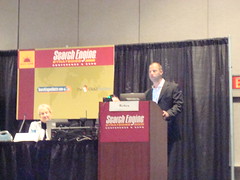If you are in the market to harvest leads from your web site, then this is the session for you! Industry experts Barbara Coll, CEO of WebMama.com, Patricia Hursh, President and Founder of SmartSearch Marketing and Adam Goldberg, Chief Innovation Officer for Clearsaleing gave some tips and insight to help B2B marketers develop search strategies to increase the number of qualified leads from their search campaigns.
Patricia kicked off the session with 10 tips for B2B Marketers!
1. Reach prospects early in the buying cycle
The sales cycle can often be long and complicated. B2B marketers rarely face the fact that people are conducting product searches at the beginning of the buying cycle. Reality is, your customers are looking for your product information way before they are ready to convert. You have to be there early!
2. Advertise in ‘the tail’
General keywords should be leveraged to reach customers early on in the buying cycle. As customers progress through the cycle, their keyword searches become more specific to the product.
3. Include non-branded keywords
Measure the search history of a person who ultimately converts on a branded term. B2B marketers typically measure the last click that converts. However, customers are searching for product information for up to 12 weeks prior to purchase. Track behavior over time, although they converted on the branded term, what initially brought them to your site? Be apart of the conversation from the beginning of their search.
4. Pre-qualified clickers
Use ad copy to pre-qualify clickers and address your specific target audience. The pros of pre-qualifying leads out-way the cons. Be specific about what you offer and who you serve.
5. Focus and align ad copy
Align ad copy with keywords. Ad copy should reflect general search terms to target customers early in the buying stage ie: lap top information. As customers move through the buying cycle, your ad copy should speak to their desire to compare brands with user reviews. When they are ready to buy, provide features specific to your product and brand.
6. Create very specific landing pages and microsite
Test microsites, focused on specific solutions and target audiences. Each microsite or landing page should focus on just one solution, with an objective to gain qualified leads. If your customers come to your home page on a targeted search keyword, they will get lost in a sea of information overload and you will loose the lead.
7. Test pages continuously
Will your registration form entice more click-through’s if it is located on the landing page or if you design a click path to reach it? Testing various options on your site can help improve conversion rates. If you are going to test, it is imperative that you track results over a period of time to determine what works and what doesn’t.
Recommended elements to test include:
– Page layouts
– Images
– Benefit statements
– Action triggers
– Names and descriptions of downloadable assets
– Registration form placement
– Registration form fields (required and optional)
8. Offer multiple action options
It’s important to offer choices. If your customers don’t want to download your software, maybe they want to take a product tour or download a white paper. What if the person isn’t ready to be contacted? Is there something else you can give them to keep the dialog going?
9. Simplify registration forms
Registration forms are typically too lengthy! There is a disconnect of the perceived value of what your customers are going to get and the process that it takes for them to get it. Test a simplified form to increase conversions. Baby step the prospects through the process and implement a robust follow up process to obtain the necessary qualifying data.
10. Turn web inquiries into sales leads
Implement a lead qualification process, starting with everyone that comes to your landing page. Next, identify the valid inquiries, followed by those that are ‘accepted’ leads. Once the lead has completed the inquiry follow up process, they are labeled as a qualified lead.
Barb specifically addressed the challenges within an enterprise wide sales force as search marketing at the enterprise level is whole new ball game. The enterprise sales force typically implements a leads ratings system to qualify their pipeline, with an obvious goal to ‘fill the pipeline’.
Where do most enterprises get ‘A’ leads? By searching their rolodex, making phone calls, or reaching out to someone they have contacted with interest in the past. This is not bad, but it’s not the only way.
Search can drive potential customers through high priority, high trust lead generation channels!
How you ask?
– Optimize more than home page and product category pages
– Point paid search clicks at aggressive lead generating pages
– Make search an A lead
So, how do you make search an “A” lead gen channel?
– Force it into the A lead bucket if it is a high converting paid search word
– Can’t treat all search traffic the same
– Educate the reps by showing them the paid search numbers
– Check to see what the reps are following up on when search leads come in
Review sales success measures, specific to the sales world, including:
– Close Rate
– Time to close
– Average selling price
– Quarterly Quota
Adam talked more about the use of technology in the B2B space and compared the online world of marketing to Maslow’s hierarchy of needs. Certain needs must be met to move up the pyramid.
Wrong Metrics = Wrong Decisions
Goal to get the cheapest lead you can is not a good goal to follow. The goal of Advertising is to drive profit.
How many of that specific lead does it take to actually close?
The best ad is that ad that is the most profitable for your business. If you are not focused on profit, you might be making decisions that look good on paper, but your ultimate goal to drive profit might not be reached.
Advertising sources sends traffic to your site; however the right technology is required to capture advertising analytics data required to make decisions.
Without the right technology, how can you determine the real value of a conversion? You need to connect the dots to know the values of each lead and sale.
The last click fallacy:
The last click does not necessarily deserve all of the credit. The buying cycle starts with problem recognition, where your customers are looking for general information online. From there, customers move into an information search, evaluation of alternatives and purchase decision. Every ad that is responsible for bringing the customer into the purchasing cycle has helped contribute to that sale. Because the last click is typically driven by a branded search, the misconception is that branded searches are really driving sales based on ‘the last click’.
If your objective is to increase qualified leads, are you driving traffic to a specific landing page or microsite?
For more photos from SES San Jose, be sure to visit TopRank on Flickr.




